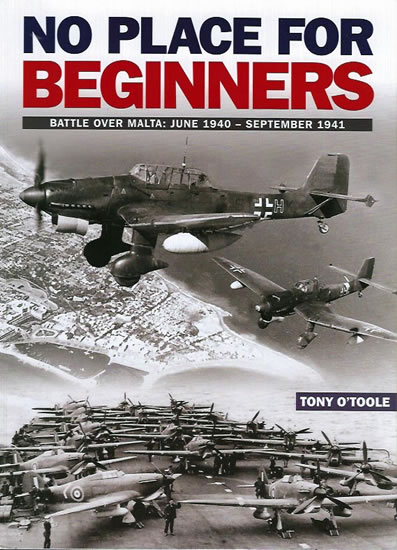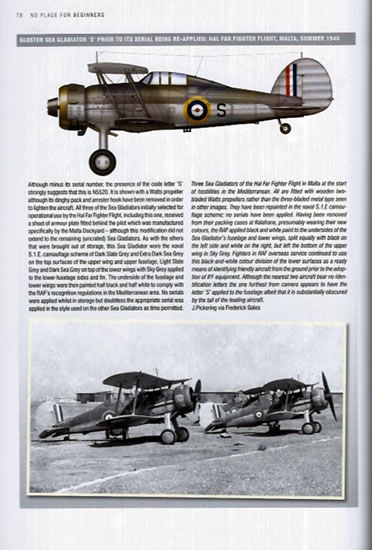No Place For Beginners
Battle Over Malta: June 1940 – September 1940

by Tony O’Toole
Dalrymple & Verdun Publishing
S u m m a r y |
Publication Details: |
No Place For Beginners
Battle Over Malta: June 1940 – September 1940
by Tony O’Toole
Dalrymple & Verdun Publishing
|
| ISBN: |
978-1-905414-18-5 |
Media and Contents: |
Soft cover; 8 x 10.5 in.; 176 pages plus covers, 132 B&W photos, 9 color photos, 30 pages of color artwork, 2 maps. |
Price: |
Price including postage: Within the UK - £24.95, Europe - £33.00, Rest of World - £36.00 from Dalrymple & Verdun |
Review Type: |
FirstRead |
Advantages: |
Excellent history of the Battle over Malta that integrates the air war with other aspects of the conflict. |
Disadvantages: |
|
Conclusion: |
This is absolutely an essential monograph on the subject. |
Reviewed by Steven Eisenman

HyperScale is proudly supported by Squadron
A 30 second history of the Battle over Malta based on most discussion forums: Malta, Britain’s bastion of __________ (fill in the blank) in the middle of the Mediterranean. The Axis of evil tried to bomb it into the Stone Age (but then again, most of Malta was stone). Operations were undertaken; Spitfires were delivered, painted in odd colors and drove the evil Nazis, and their Italian friends, from the skies. The Maltese got a medal.
I would now like to recommend that anyone with the slightest interest in the Battle over Malta spend more than 30 seconds, a few hours perhaps, with this excellent monograph to gain a fuller understanding of the history and of the many, many aspect of the Battle.
This monograph is the first part of a two-volume set that attempts to cover the Battle from the decision to defend Malta to the…. (Since I have not seen the second volume, we’ll have to wait for the ending). It is clear from the amount of research that went into Mr. O’Toole’s work, and his intended purpose, that two volumes are necessary.

Unlike many monographs on the subject of air wars over this place or that, Mr. O’Toole does not reduce the events to a simple diary of missions and sorties. Nor is it a stringing together of remembrances. Rather, the author weaves the story of the combat in the air together with events occurring on the ground and sea, and the military decisions and politics of the RAF, Admiralty and FAA.
Although I am not well versed on the subject matter, it clearly appears that the author did extensive, and exhaustive research before putting fingers to keyboard. But, the result is not at all dry and uninvolving. On the contrary, the facts are used to tell a most interesting historical tale. The human element is not forgotten for one moment. We learn of the dangers of flying in shorts and shirt and the blame assigned for the failure of a ferry flight.
There was much new that I learned (Make that quite a lot!). For example, the fact that such an extensive network of aircraft taxiways was developed that the airfields on the main island became interconnected. I learned that a “secret weapon” had been developed for the Fulmars to provide for a rear-defense. The myth of Faith, Hope and Charity was explained. Then there were the different ways to construct the protective aircraft pens.
Also, while Malta is usually seen as the victim of Axis barbarity, it was also the base from which significant offensive actions were launched. In fact, just after I finished this monograph, I was sent a copy of an Admiralty secret cypher message complaining that the BBC’s blabbed about where an offensive raid against Naples originated.
Finally, after finishing this monograph, one is left with the impression that it may have been the nature of the enemy, the Italians, that allowed Malta a margin of survival through this period. Clearly, the second volume is intended to pick up with the Germans reasserting themselves and the long awaited arrival of the Spitfires.
As this is a monograph about air warfare, the aircraft are not shortchanged. The types and use of the various aircraft are fully explained. I was quite surprised by the various types of aircraft that were involved during this period in the Battle over Malta. We learn new nicknames for some. There are a significant number of pictures of both British and Axis aircraft that are specifically tied to Malta. The captions are extensive and go into significant detail. The profiles are well done and well explained, and the author discusses the camouflage involved.
Mr. O’Toole seems to reasonably explain the coloration of Beaufighter Ic T5038 “V”. In some pictures it appears to be in Dark Earth and Middle Stone, in others like a Temperate Sea Scheme. Of course there is room for disagreement. Hurricanes the author describes as being in Dark Green and faded Dark Earth could be seen as being in a scheme of Dark Green and Middle Stone.
I am left with only one conclusion; that this well researched and well written monograph is absolutely essential reading on the subject of Malta, and the Mediterranean and North African theaters of conflict in World War Two.
The monograph is printed on high quality, heavy weight paper, with excellent image reproduction. If anything, the surface may be a bit too reflective.
On a side note, some the pictures in this monograph may give tank and vehicle modelers inspiration to do a unique style of camouflage.
Thanks to Dalrymple & Verdun to for the review sample.
Review Copyright 2013 by Steven Eisenman
This Page Created on 17 December, 2013
Last updated
3 June, 2016
Back to HyperScale Main Page
Back to Reviews Page

|
